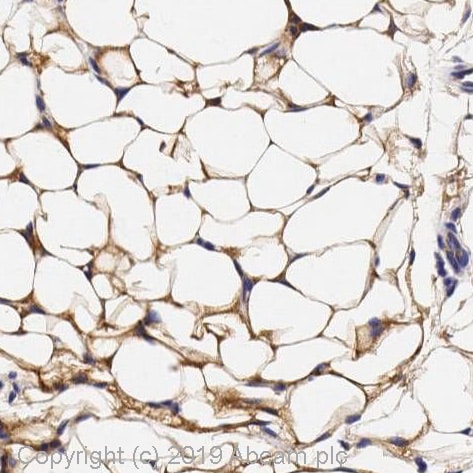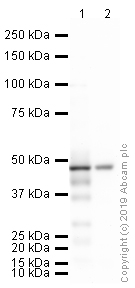Anti-beta 3 Adrenergic Receptor antibody (ab94506)
Key features and details
- Rabbit polyclonal to beta 3 Adrenergic Receptor
- Suitable for: WB, IHC-P
- Reacts with: Mouse, Rat
- Isotype: IgG
Overview
-
Product name
Anti-beta 3 Adrenergic Receptor antibody
See all beta 3 Adrenergic Receptor primary antibodies -
Description
Rabbit polyclonal to beta 3 Adrenergic Receptor -
Host species
Rabbit -
Tested applications
Suitable for: WB, IHC-Pmore details -
Species reactivity
Reacts with: Mouse, Rat -
Immunogen
Synthetic peptide. This information is proprietary to Abcam and/or its suppliers.
(Peptide available asab108460) -
Positive control
- WB: Mouse brown adipose tissue lysate. IHC-P: Mouse pancreas tissue. Mouse Adipose, Mouse Bladder, Mouse ovary.
-
General notes
Reproducibility is key to advancing scientific discovery and accelerating scientists’ next breakthrough.
Abcam is leading the way with our range of recombinant antibodies, knockout-validated antibodies and knockout cell lines, all of which support improved reproducibility.
We are also planning to innovate the way in which we present recommended applications and species on our product datasheets, so that only applications & species that have been tested in our own labs, our suppliers or by selected trusted collaborators are covered by our Abpromise™ guarantee.
In preparation for this, we have started to update the applications & species that this product is Abpromise guaranteed for.
We are also updating the applications & species that this product has been “predicted to work with,” however this information is not covered by our Abpromise guarantee.
Applications & species from publications and Abreviews that have not been tested in our own labs or in those of our suppliers are not covered by the Abpromise guarantee.
Please check that this product meets your needs before purchasing. If you have any questions, special requirements or concerns, please send us an inquiry and/or contact our Support team ahead of purchase. Recommended alternatives for this product can be found below, as well as customer reviews and Q&As.
Images
-
All lanes : Anti-beta 3 Adrenergic Receptor antibody (ab94506) at 1 µg/ml
Lane 1 : Brown Adipose (Mouse) Tissue Lysate
Lane 2 : Brown Adipose (Rat) Tissue Lysate
Lysates/proteins at 10 µg per lane.
Secondary
All lanes : Goat Anti-Rabbit IgG H&L (HRP) (ab97051) at 1/50000 dilution
Developed using the ECL technique.
Performed under reducing conditions.
Predicted band size: 43 kDa
Observed band size: 44 kDa why is the actual band size different from the predicted?
Exposure time: 8 minutesThis blot was produced using a 4-12% Bis-tris gel under the MOPS buffer system. The gel was run at 200V for 50 minutes before being transferred onto a Nitrocellulose membrane at 30V for 70 minutes. The membrane was then blocked for an hour using 2% Bovine Serum Albumin before being incubated with ab94506 overnight at 4°C. Antibody binding was detected using an anti-rabbit antibody conjugated to HRP, and visualised using ECL development solution.
-
 Immunohistochemistry (Formalin/PFA-fixed paraffin-embedded sections) - Anti-beta 3 Adrenergic Receptor antibody (ab94506)
Immunohistochemistry (Formalin/PFA-fixed paraffin-embedded sections) - Anti-beta 3 Adrenergic Receptor antibody (ab94506)IHC image of beta 3 Adrenergic Receptor staining in Mouse adipose (white) tissue formalin fixed paraffin embedded tissue section, performed on a Leica Bond™ system using the standard protocol F. The section was pre-treated using heat mediated antigen retrieval with sodium citrate buffer (pH6, epitope retrieval solution 1) for 20 mins. The section was then incubated with ab94506, 5µg/ml, for 15 mins at room temperature and detected using an HRP conjugated compact polymer system. DAB was used as the chromogen. The section was then counterstained with haematoxylin and mounted with DPX.
For other IHC staining systems (automated and non-automated) customers should optimize variable parameters such as antigen retrieval conditions, primary antibody concentration and antibody incubation times.
-
 Immunohistochemistry (Formalin/PFA-fixed paraffin-embedded sections) - Anti-beta 3 Adrenergic Receptor antibody (ab94506)
Immunohistochemistry (Formalin/PFA-fixed paraffin-embedded sections) - Anti-beta 3 Adrenergic Receptor antibody (ab94506)IHC image of beta 3 Adrenergic Receptor staining in Mouse Ovary Normal tissue formalin fixed paraffin embedded tissue section, performed on a Leica Bond™ system using the standard protocol F. The section was pre-treated using heat mediated antigen retrieval with sodium citrate buffer (pH6, epitope retrieval solution 1) for 20 mins. The section was then incubated with ab94506, 5µg/ml, for 15 mins at room temperature and detected using an HRP conjugated compact polymer system. DAB was used as the chromogen. The section was then counterstained with haematoxylin and mounted with DPX.
For other IHC staining systems (automated and non-automated) customers should optimize variable parameters such as antigen retrieval conditions, primary antibody concentration and antibody incubation times.
-
 Immunohistochemistry (Formalin/PFA-fixed paraffin-embedded sections) - Anti-beta 3 Adrenergic Receptor antibody (ab94506)
Immunohistochemistry (Formalin/PFA-fixed paraffin-embedded sections) - Anti-beta 3 Adrenergic Receptor antibody (ab94506)IHC image of beta 3 Adrenergic Receptor staining in Mouse Bladder Normal tissue formalin fixed paraffin embedded tissue section, performed on a Leica Bond™ system using the standard protocol F. The section was pre-treated using heat mediated antigen retrieval with sodium citrate buffer (pH6, epitope retrieval solution 1) for 20 mins. The section was then incubated with ab94506, 5µg/ml, for 15 mins at room temperature and detected using an HRP conjugated compact polymer system. DAB was used as the chromogen. The section was then counterstained with haematoxylin and mounted with DPX.
For other IHC staining systems (automated and non-automated) customers should optimize variable parameters such as antigen retrieval conditions, primary antibody concentration and antibody incubation times.
-
Anti-beta 3 Adrenergic Receptor antibody (ab94506) at 1 µg/ml + Brown Adipose (Mouse) Tissue Lysate at 20 µg
Secondary
Goat Anti-Rabbit IgG H&L (HRP) (ab97051) at 1/10000 dilution
Developed using the ECL technique.
Performed under reducing conditions.
Predicted band size: 43 kDa
Observed band size: 44 kDa why is the actual band size different from the predicted?
Additional bands at: 22 kDa. We are unsure as to the identity of these extra bands.
Exposure time: 2 minutesThis blot was produced using a 4-12% Bis-tris gel under the MOPS buffer system. The gel was run at 200V for 50 minutes before being transferred onto a Nitrocellulose membrane at 30V for 70 minutes. The membrane was then blocked for an hour using 5% Bovine Serum Albumin before being incubated with ab94506 overnight at 4°C. Antibody binding was detected using an anti-rabbit antibody conjugated to HRP, and visualised using ECL development solution.
-
All lanes : Anti-beta 3 Adrenergic Receptor antibody (ab94506) at 1 µg/ml
Lane 1 : Mouse ovary tissue lysate
Lane 2 : Mouse bladder tissue lysate
Lysates/proteins at 25 µg per lane.
Secondary
All lanes : Goat Anti-Rabbit IgG H&L (HRP) (ab97051) at 1/50000 dilution
Developed using the ECL technique.
Performed under reducing conditions.
Predicted band size: 43 kDa
Exposure time: 20 minutesThis blot was produced using a 4-12% Bis-tris gel under the MOPS buffer system. The gel was run at 200V for 50 minutes before being transferred onto a Nitrocellulose membrane at 30V for 70 minutes. The membrane was then blocked for an hour using 2% Bovine Serum Albumin before being incubated with ab94506 overnight at 4°C. Antibody binding was detected using an anti-rabbit antibody conjugated to HRP, and visualised using ECL development solution.
-
 Immunohistochemistry (Formalin/PFA-fixed paraffin-embedded sections) - Anti-beta 3 Adrenergic Receptor antibody (ab94506)
Immunohistochemistry (Formalin/PFA-fixed paraffin-embedded sections) - Anti-beta 3 Adrenergic Receptor antibody (ab94506)IHC image of beta 3 Adrenergic Receptor staining in Mouse pancreas formalin fixed paraffin embedded tissue section, performed on a Leica BondTM system using the standard protocol F. The section was pre-treated using heat mediated antigen retrieval with sodium citrate buffer (pH6, epitope retrieval solution 1) for 20 mins. The section was then incubated with ab94506, 10µg/ml, for 15 mins at room temperature and detected using an HRP conjugated compact polymer system. DAB was used as the chromogen. The section was then counterstained with haematoxylin and mounted with DPX.
For other IHC staining systems (automated and non-automated) customers should optimize variable parameters such as antigen retrieval conditions, primary antibody concentration and antibody incubation times.




















